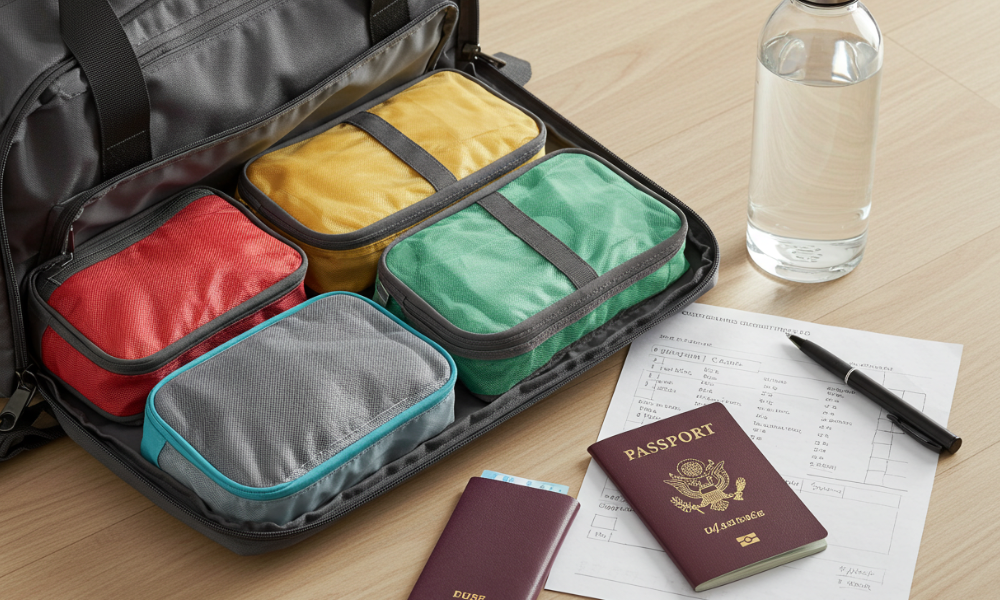Traveling can be exhilarating, but it often comes with challenges like delayed flights, language barriers, or overpacked schedules. For minimalist travelers, adopting simple habits streamlines the journey, enhancing efficiency and enjoyment while keeping your 20–30L backpack light. These practices, honed during my trips across Southeast Asia and beyond, require minimal effort and gear, ensuring smoother adventures from Hanoi’s bustling streets to Peru’s quiet trails. Here’s a guide to seven travel habits that make every trip effortless, budget-friendly ($20–40/day), and stress-free.

Why Simple Habits Transform Travel
Small, intentional routines prevent common travel pitfalls—lost items, wasted time, or budget overruns—letting you focus on experiences like sampling street food or exploring temples. On my Vietnam trip, these habits saved me $50 by avoiding fees and kept daily costs at $25, proving simplicity enhances travel. Requiring just a phone, notebook, and lightweight essentials, they align with minimalist principles for a seamless journey.
1. Pack Light with a Capsule Wardrobe
Overpacking burdens you with heavy bags and fees ($30–100/trip). A 20–30L backpack (e.g., Osprey Daylite, $50) under 7 kg meets carry-on limits (e.g., AirAsia) and keeps you agile. In Thailand, my capsule wardrobe (3 tops, 2 bottoms, $10–30 each, 5 underwear, sandals $10–20) fit all climates (30°C/86°F). Wash clothes every 3–4 days with travel soap ($5) to stay fresh. How to Do It: Follow the 1-2-3-4-5-6 rule (1 hat, 2 shoes, 3 bottoms, 4 tops, 5 socks, 6 underwear). Use packing cubes ($10–20) to organize. Test bag weight pre-trip.
Why It Works: Reduces fees, simplifies transport (tuk-tuks, buses), and eases border crossings.
Cost Savings: $30–100/trip; gear $50–100 one-time.
2. Download Offline Apps Before Departure
Lost without Wi-Fi? Offline apps like Maps.me, Google Translate (language packs, e.g., Vietnamese), and Wikivoyage (free) ensure navigation and communication. In Cambodia, Maps.me guided me to Psar Chas without data, saving $5 on taxis. Download a currency converter (e.g., XE, free) and local ride apps (e.g., Grab, free) for fares ($1–3). A portable charger ($15–30) keeps your phone alive. How to Do It: Install apps 1–2 days pre-trip. Download city maps and language packs. Save key routes (e.g., hostel to market). Charge devices nightly.
Why It Works: Eliminates data reliance, saving $5–10/month on SIMs.
Cost: $0–30 for charger; SIM optional ($5 for 30GB/14 days).
3. Keep Digital and Physical Copies of Documents
Losing your passport or visa can cost $100–500 and days of stress. Store digital copies (passport, visas, tickets) on Google Drive (free) or email, and carry a photocopy ($0.50) in a money belt ($10). In Laos, my digital backup sped up a hostel check-in when my passport was locked away. Keep $50–100 cash (local currency) split between belt and pocket for emergencies. How to Do It: Scan documents pre-trip; upload to cloud. Print 1–2 copies. Use a money belt under clothes. Note embassy contacts in a notebook ($3).
Why It Works: Ensures quick recovery from loss, avoiding delays or fees.
Cost: $10–13 for belt/notebook; $0.50 for copies.
4. Plan One Key Activity Per Day
Overscheduling leads to burnout and missed moments. Focus on one main activity—like Angkor Wat ($37, Cambodia) or Hanoi’s Old Quarter (free)—and let the rest flow. In Chiang Mai, I prioritized Doi Suthep Temple ($1), then wandered markets spontaneously, saving $10 on rushed tours. Write the day’s plan in a notebook ($3) or phone notes (free) each evening. How to Do It: Pick 1 must-do (museum, hike) pre-trip or nightly. Research hours/costs on X or Wikivoyage. Leave afternoons open for flexibility.
Why It Works: Reduces stress, maximizes enjoyment, and keeps activities at $0–10/day.
Time: 5 minutes/night.
5. Eat Local to Save Money and Stay Healthy
Street food ($0.50–2/meal) is cheaper and often fresher than restaurants ($5–10). In Vietnam, I ate phở ($0.75) at busy stalls, saving $10/day. Choose high-turnover vendors to avoid foodborne illness; use hand sanitizer ($3) before eating. Carry a reusable container ($10) for leftovers and a water bottle ($15) to skip bottled drinks ($0.50–1). Learn “no spice” (e.g., “mai pet” in Thai) to adjust flavors. How to Do It: Visit markets during peak hours (6–8 PM). Sanitize hands; check stall hygiene. Pack container for extras. Learn 1–2 food phrases.
Why It Works: Cuts food costs by 50–80%, keeping daily spend at $5–8.
Cost Savings: $150–300/month.
6. Use Local Transport Strategically
Taxis ($5–20) drain budgets; local buses ($0.30–2), ride-hailing (Grab, $1–3), or bikes ($1–3/day) are cheaper. In Kuala Lumpur, I used LRT trains ($0.50) to Batu Caves, saving $5 over Grab. Research routes via Moovit or Rome2Rio (free). Book night buses ($5–15) via 12Go to save accommodation. Walk compact areas (e.g., Luang Prabang) with offline Maps.me for safety. How to Do It: Download Moovit/Grab pre-trip. Carry small cash for fares. Book buses 1–2 weeks ahead. Walk 1–2 km routes to save $1–2/day.
Why It Works: Keeps transport at $2–5/day, saving $60–150/month.
Cost Savings: $5–10/day vs. taxis.
7. Stay Flexible with a Buffer Fund
Unexpected delays (missed buses, $5–20) or opportunities (festivals, $2–10) arise often. Keep a $50–100 buffer in your budget, split between cash (local currency) and card (e.g., Monzo, low fees). In Bali, my $10 buffer covered a spontaneous Ubud dance show ($5). Check X for “[destination] travel tips” to anticipate costs. Share plans with a friend via WhatsApp (free) for safety. How to Do It: Allocate $3–7/day for surprises. Carry $20–50 cash in a money belt ($10). Verify costs on X or hostel boards. Text plans daily (1 minute).
Why It Works: Handles surprises without derailing your $20–40/day budget.
Cost: $50–100/trip, often unspent.
Minimalist Travel Tips
- Pack Light: Carry a 20–30L backpack ($50) with capsule wardrobe ($10–30/item), water bottle ($15), container ($10), sanitizer ($3), and notebook ($3). Total <7 kg.
- Budget Wisely: Aim for $20–40/day ($5–10 hostel, $5–8 food, $2–5 transport, $2–10 activities). Save $5–20/day with local habits.
- Stay Prepared: Download offline apps (Maps.me, Translate, free). Carry a portable charger ($15–30) and $50–100 cash. Wash clothes with travel soap ($5).
- Cultural Respect: Learn greetings (e.g., “xin chào” in Vietnam) and dress modestly (scarf, $5) for temples or villages.
- Safety First: Keep valuables in a money belt ($10). Check X for “[city] safety tips.” Carry a first-aid kit ($5) for minor issues.
- Plan Smart: Travel in shoulder seasons (April–May, Sept–Oct) for deals. Book hostels 1–2 weeks via Hostelworld; transport via 12Go.
Why These Habits Work
These travel habits streamline logistics, cut costs, and enhance flexibility, using minimal tools (phone, notebook, bottle) for a light 20L pack. They saved me $100 on my Laos trip by avoiding fees and scams, keeping daily costs at $25 while exploring temples and markets. Tailored for minimalist travelers, they reduce stress and maximize joy, whether navigating Siem Reap’s tuk-tuks or Cusco’s trails. Compared to unplanned travel ($50–100/day), these habits save $20–60/day.




lznnxnwpgoppxhmmjpsxuhqpzokryi